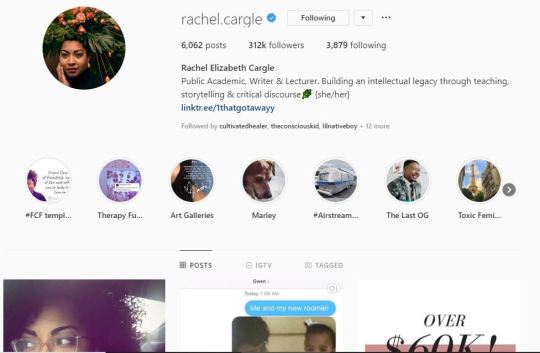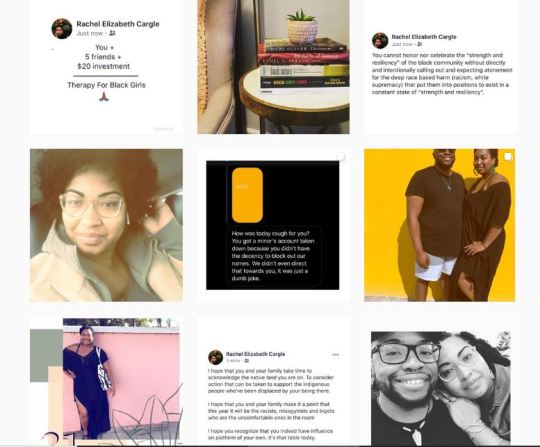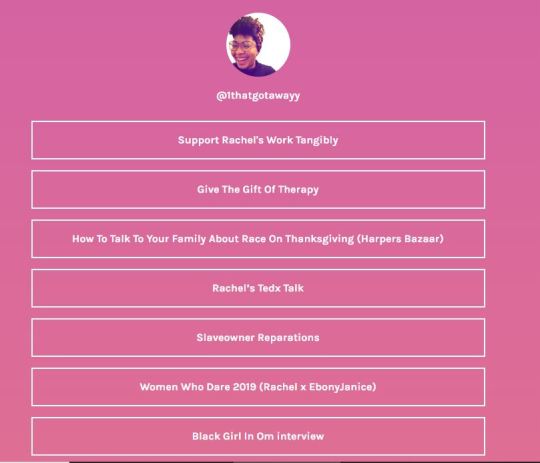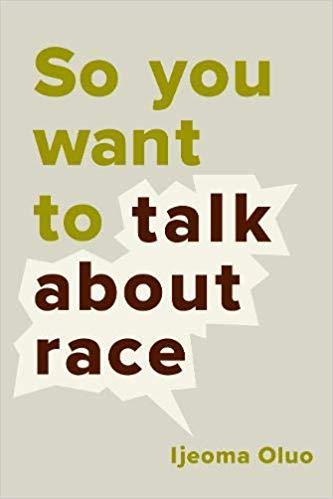Text
Instagram (@rachel.cargle)
For my social media selection I decided to pick Instagram but specifically I wanted to focus on Rachel Elizabeth Cargle. Her username on Instagram is @rachel.cargle. On her website she writes, “Rachel Cargle is a public academic, writer, and lecturer. Her activist and academic work are rooted in providing intellectual discourse, tools, and resources that explore the intersection of race and womanhood. Her social media platforms boast a community of over 260k where Rachel guides conversations, encourages critical thinking and nurtures meaningful engagement with people all over the world” (Cargle, 2018).


I have been following Cargle for a couple of years now and I think she does amazing work and provides education through social media. Instagram is mostly known for famous people, sharing photos of your life, influencers, and stalking strangers. Rachel has adapted into using her social media to spread messages that could help people understand serious issues relating to race, ethnicity, gender, etc. She addresses all areas of identity but she does focus on women and being African American. Clearly her expertise lies in her own experience and she can speak to those from her heart. Cargle even appeared on a TEDx Talk, Coming to Terms With Racism’s Inertia: Ancestral Accountability in 2019 which I will publish below.
youtube
(Cargle, 2019)
This relates to the course because she touches on problems that minorities face. She expands her own knowledge to share with others so that hopefully it will open discussion between people. She uses her social media power to share stories of marginalized people and events happening around the world that we should pay attention too. I think she approaches this with great strategy because she opens up her platform to let others speak when normally their voice may not be heard or could be drowned out by others. This allows people to voice their opinions or feelings on certain topics and raises overall awareness.

Rachel is an African American woman so she is already someone who knows what intersectionality means and can speak to how her various identities have impacted her day to day life. She finds it very important to highlight systemic issues and how deeply racism is rooted in our society, but when she discusses this she provides positivity and hope for her readers who are people of color or a part of a marginalized group.

(https://linktr.ee/1thatgotawayy)
This Instagram account opens up a new space for people to talk about issues pertaining to race and ethnicity in the U.S. Rachel provides resources like videos, seminars, articles, books, anything that could help someone who wanted to learn and better understand the issues that many minorities face. She addresses white privilege through readings very similar as us like White Privilege: Unpacking The Invisible Knapsack by Peggy McIntosh. This is unique because Instagram has not been the biggest platform for social justice movements until this past year or two, but her page shows no sign of stopping growth. She uses all her social media platforms and often shares links or screenshots of her posts from Facebook onto Instagram. So this allows people who may not be on the other platforms to see it on Instagram and hopefully promote positive change and growth.
One amazing resource that Rachel provides on her Instagram, as I stated earlier, is books and articles. One recommendation stood out to me and I picked it up at my local library. This book is titled, So You Want to Talk About Race by Ijeoma Oluo. This book really helped me learn how to discuss race, ethnicity, and it also helped me better understand myself as a white passing person of color. It put me in my place and helped me see my power and privilege and how I can use that going forward to give the platform to quieter voices.

Citations:
Cargle, R. (n.d.). Home: rachel-cargle. Retrieved from https://www.rachelcargle.com/.
Cargle, R. (n.d.). @1thatgotawayy. Retrieved from https://linktr.ee/1thatgotawayy.
Mcintosh, P. (2019). White Privilege: Unpacking the Invisible Knapsack (1989) 1. On Privilege, Fraudulence, and Teaching As Learning, 29–34. doi: 10.4324/9781351133791-4
Cargle, Rachel. [ TEDx Talks]. (2019, Sept. 3). Coming to Terms With Racism’s Inertia: Ancestral Accountability | Rachel Cargle | TEDxBend [Youtube]. Retrieved from https://www.youtube.com/watch?v=VgufOtRq488&feature=youtu.be
Oluo, I. (2018). So You Want to Talk About Race. New York: Seal Press.
Rachel Elizabeth Cargle (@rachel.cargle) • Instagram photos and videos. (n.d.). Retrieved from https://www.instagram.com/rachel.cargle/.
0 notes
Text
Moonlight (2016 Film)
Over the recent years a new term has began to appear more and more in the fields of social science. It has come to the attention of many that while studying a person, various factors play into said person’s life essentially creating who they are. People have realized that focusing on multiple skews creates a deeper analysis and greater understanding of people. The term Intersectionality is defined as “The interconnected nature of social categorizations such as race, class, and gender as they apply to a given individual or group, regarded as creating overlapping and interdependent systems of discrimination or disadvantage” (oxford dictionary). In Moonlight, director Barry Jenkins portrays a very different and normally unseen side of intersectionality within the film realm. Jenkins uses the powerful story of the life of a gay black man living in Miami, Florida to show his audience the complicated world of intersectionality. He shows this by having the audience follow the main character, Chiron, through three different stages of his life and how his life is affected during each stage by his sexuality, race, and income.

In the film Moonlight, we see a struggling boy throughout his childhood, adolescence, and adulthood. These sections can be split up and labeled by the three different nicknames given to him throughout the movie: Little, Chiron, and Black, in that order. Through each stage of the film, the viewer begins to build the puzzle that is Chiron’s life. By seeing him age in each section, the viewer is able to watch specific events involving Chiron’s sexuality, race and income and how they shape him from Little into his final persona, Black. The audience sits back and makes the connections as to why Black ends up as, or attempts to portray, a “hard” man. All of the components of being a black gay man living in poverty have come together to create Black. Showing this growth in each segment helps the viewer see how all of these have played a very important role in Chiron's upbringing.
youtube
Throughout each segment, multiple types of masculinities are shown in different characters. From the beginning of this childhood to well into his teenage years, we can see toxic masculinity in the bullies that torment Chiron for his sexuality before he even understands what being gay means. The neighborhood where Chiron is raised is full of “hetero-patriarchal masculinity” (Nkumane, 2017) while his own masculinity is so different from those surrounding him. The actor Andre Holland, who plays the adult version of Kevin states, "There's often this idea of boys don't cry and toughen up, man up, and at the same time, well, don’t be too angry or too aggressive, because that has serious ramifications, as we continue to see” (Barco, 2016). We can see this confusion during the whole film about what it means to be a man, especially in Chiron’s circumstances, which differ greatly from the lives of most viewers. How does one become a man with little to no parental guidance, while enduring the impact of institutionalized racism, living in the hood, and battling their sexuality and what that means to them? Moonlight shows the complexity and multiplicity of black masculinities.

Gender plays a very important role in the overall scheme of intersectionality. We must recall that Chiron is a man but we must recognize that he is a black man, which creates a very different reality from that of a white man. Being a black man, Chiron experiences greater risk and vulnerability in life (Rich, 2014). Even without stating it directly in the film, the viewer can still see the implications of systematic racism throughout the movie and the impact it had on this impoverished black community. Just based alone on data of the disproportionate number of incarcerated black men to white men, we can see privileges that white men hold over men of color (Rich, 2014). This movie does not portray racism at the individualized level, but rather a higher level, in the ways that Chiron’s life is highly disadvantaged in many aspects based on the impacts that white supremacy has had on the black community (Kannan et al., 2017). The story gives the audience a look into how an unequal playing field shapes Chiron’s future as the black characters must come face to face with an oppressive system. The color of his skin directly impacts the life Chiron leads even before he is born. Moonlight is a film about “racism without racists” (Bonilla-Silva 2010). So although Chiron has the privileges of being a man, he still is not at the same level as a white man and does not hold nearly the same amount of power that a white man would. However he still holds a higher place in the world than others because he does benefit from the patriarchal system.
youtube
Citations
Barco, M. D. (2016, October 18). In 'Moonlight,' Growing Up Black, Gay And Poor In 1980s Miami. Retrieved from https://www.npr.org/2016/10/18/498358778/moonlight-coming- of-age-in-miami-during-the-war-on-drugs-era
Bonilla-Silva, E. (2010). Racism without racists: Color-blind racism and the persistence of racial inequality in America. Lanham: Rowman & Littlefield.
Intersectionality. (2018). In the Oxford Dictionary.
Kannan, M., Hall, R., & Hughey, M. W. (2017). Watching Moonlight in the Twilight of Obama. Humanity & Society,41(3), 287-298. doi:10.1177/0160597617719889
Nkumane, Z. (2017, March 01). Moonlight, A Refreshing Sermon On Black Masculinity. Retrieved from https://www.huffingtonpost.co.za/zanta-nkumane/moonlight-a-refreshing-sermon-on-black-masculinity_a_21715404/
Rich, C. (2014). Angela Harris and the Racial Politics of Masculinity: Trayvon Martin, George Zimmerman, and the Dilemmas of Desiring Whiteness. California Law Review, 102(4), 1027-1052. Retrieved from http://www.jstor.org/stable/23784359
Baldoni , J. (2018, January 3). Why I'm done trying to be a man. Retrieved from https://www.youtube.com/watch?v=Cetg4gu0oQQ.
0 notes
Text
Dear White People
For my TV show choice I decided to analyze Dear White People which was created by Justin Simien. It is a Netflix original show that premiered in 2017 and has had several more seasons since. It did stir up a lot of controversy because it makes a lot of statements regarding the current political and social climates. The show specifically follows a group of black students who attend an ivy league school. It is full of representation and calls out many difficulties that the young black students face and have previously faced in their lives. Below is the trailer for the first season of the show (Dear White People, 2014).
youtube
Dear White People uses comedy alongside the drama to bring light to a subject that can become very dark and daunting. It is easy to feel hopeless when racism is still very present and powerful in our everyday lives. That is why so many people became upset when the series premiered. A lot of white people felt criticized and even attacked. They felt as though the show generalized all white people as being awful and oblivious to racism. The show is brave in making such strong statements, so the reactions of people being angry about feeling “called out” is not surprising.
The creator uses TV as a platform to point out injustices and call out people for not seeing or understanding their privileges as white people. While following several marginalized students it allows the viewer to connect and learn from their stories and experiences. Dear White People helps outsiders to see and feel the every day struggles as well as systemic oppression that black people must deal with just because of their skin color. It also uses intersectionality because each character deals with other struggles outside of race issues. For example, other characters deal with poverty and coming to terms with their sexuality. Each person has a very different story and the show highlights the differences various identities create. This video, by the National Museum of African American History and Culture, explains this often misunderstood term while providing important historical and cultural context.
youtube
Dear White People creates an opening for a very important conversation. With racial tension at an all time high, younger generations are beginning to speak out and speak up. Using their platforms to try to share their experiences and work towards change. This is one of the first shows to really generate a conversation on the systemic racism that people of color face even in an ivy league college. The system has continuously worked against them and their race and ethnic groups created many more barriers they had to cross in order to be successful. The characters had to work hard to get in their places and yet they still experience racism on their campus and from people of high importance at the university. They are often told to speak quieter when they begin to call out others behavior. The university cares more about their image than of the livelihood of their students of color, going so far as to try to get rid of the blacks only dorm on campus and force them to assimilate among their other peers. People have turned a blind eye and tried to erase color. Mellody Hobson addresses the issues around the concept of being color blind in her Ted Talk (2014).
youtube
All of these issues are a reality and many people thanked the creator for putting this on the screens of millions of Netflix subscribers. These stories are so important in creating change in the real world. People can gain a different perspective that they may have never been exposed to. It uses an entertaining show to spread real awareness and education on what it is currently like to be a young black person in the United States. More and more young black Americans are using art to express their content with aspects of their lives. Another example is Donald Glover, aka Childish Gambino and the release of his song titled, This Is America. I embedded this song in the playlist on my blog along with many others that speak to racial issues that people of color highlight with their lyrics.
Citations
#APeoplesJourney: African American Women and the Struggle for Equality. (2017, August 29). Retrieved from https://youtu.be/X5H80Nhmn20.
Dear White People Official Trailer #1 (2014) - Comedy HD. (n.d.). Retrieved from https://www.youtube.com/watch?v=JMgWMzbM2Pk.
Glover, D. (2017). Childish Gambino. [online] Universal Music Publishing Group. Available at: http://www.umusicpub.com/us/Artists/C/Childish-Gambino.aspx [Accessed 16 Jul. 2017].
1 note
·
View note